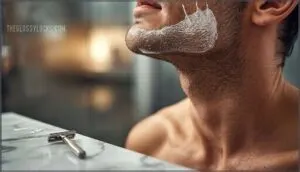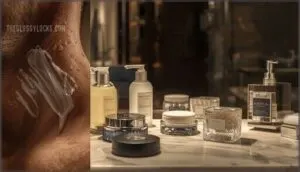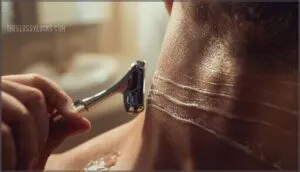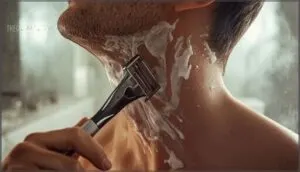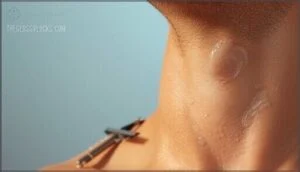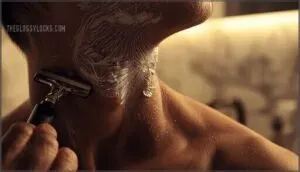This site is supported by our readers. We may earn a commission, at no cost to you, if you purchase through links.

The skin stretches, the angles shift, and those follicles point sideways, upward, and sometimes in spirals that make no anatomical sense. Learn to map that chaos, flatten the terrain, and adjust your blade angle, and you’ll transform the most dreaded part of your routine into the smoothest.
The difference between a clean neckline and an irritated mess comes down to technique, not luck.
Table Of Contents
- Key Takeaways
- Why Shaving The Neck is Challenging
- Preparing Your Neck for a Close Shave
- Choosing The Best Razor for Neck Shaving
- Selecting Shaving Creams, Soaps, and Gels
- Mastering Neck Hair Growth Direction
- Step-by-Step Neck Shaving Technique
- Shaping and Maintaining The Neckline
- Preventing Razor Burn and Ingrown Hairs
- Essential Post-Shave Care for The Neck
- Common Neck Shaving Mistakes to Avoid
- Frequently Asked Questions (FAQs)
- Conclusion
Key Takeaways
- Your neck’s hair grows in chaotic, multi-directional patterns that differ completely from your face, which is why treating them the same guarantees irritation—mapping the grain and adjusting your blade angle to match those patterns is the only way to transform the neck from a problem zone into your smoothest area.
- Sharp blades, proper skin preparation with warm water and pre-shave products, and maintaining light pressure with short strokes (1-2 inches) cut irritation by 15-30% and prevent the razor burn that comes from dull blades or aggressive technique.
- Shaving with the grain first—not against it—reduces irritation by 60% and cuts razor bump risk by two-thirds, because respecting your mapped growth direction protects the neck’s thinner, more vulnerable skin while still delivering clean results.
- Stretching the skin taut behind your razor, using minimal passes, and following up immediately with alcohol-free aftershave and moisturizer within 30 seconds prevents the ingrown hairs, micro-cuts, and inflammation that turn most neck shaves into disasters.
Why Shaving The Neck is Challenging
The neck isn’t just another patch of skin—it’s a minefield of tricky angles, unpredictable hair patterns, and thin skin that rebels at the first sign of a dull blade.
Most guys struggle here because they treat it like their face, but the neck plays by different rules. Let’s break down exactly why this area demands your attention and a smarter approach.
Unique Neck Hair Growth Patterns
Here’s the brutal truth: your neck’s hair follicle density and growth patterns are pure chaos. Unlike your face, neck hair doesn’t follow a single direction—it forms whorls, spirals, and multi-directional flows that vary person to person. This complexity comes from genetic influences and neck anatomy itself.
Your neck’s hair doesn’t follow a single direction—it forms chaotic whorls, spirals, and multi-directional flows that vary person to person
Your neck hair growth pattern creates distinct challenges:
- Ventral regions (front) activate growth cycles earlier than back areas
- Hair direction shifts across different anatomical zones unpredictably
- Follicle density varies by region, affecting texture and thickness
- Ethnic and hormonal factors alter terminal hair characteristics
- Scars and structures disrupt hair growth wave propagation
Understanding hair growth direction through grain mapping is your foundation for mastering the shave. Skip this step, and you’re fighting biology itself. Managing hormonal imbalances is essential for effective neck hair management.
Sensitive Skin and Irritation Risks
Your neck’s skin structure puts it at a severe disadvantage. Nearly 60% of men experience skin irritation in sensitive areas after shaving—the neck’s thinner epidermis and compromised hydrolipid barrier leave raw layers exposed to friction. Razor-induced microtrauma causes visible redness and burning.
Studies confirm 41% of men with sensitive skin report post-shave inflammation. Preventing razor burn demands understanding this vulnerability before the blade touches the skin.
To minimize irritation, it’s vital to consider the effects of shaving sensitive skin and take necessary precautions.
Common Neck Shaving Problems
Razor burn, ingrown hairs, and nicks dominate neck shaving problems. Clinical data shows up to 58% of men experience redness immediately after shaving the neck—markedly higher than other facial areas. One in four males report cuts, bumps, or irritation concentrated below the jawline.
Infections develop when bacteria enter razor-induced skin cracks, sometimes requiring antibiotic treatment. Understanding these hazards prepares you to prevent them.
Preparing Your Neck for a Close Shave
Your neck doesn’t stand a chance unless you prepare it right. Skip the prep, and you’re setting yourself up for irritation, razor burn, and a shave that looks sloppy instead of sharp.
Here’s how to get your skin ready so the blade glides clean and you walk away smooth.
Cleansing and Softening The Skin
Before you touch a razor, clean your face properly. A gentle cleanser removes surface oils and debris, cutting ingrown hair risk by 15%. Proper skin cleansing boosts softness by up to 30%, which means smoother razor glide.
Exfoliation strips away dead skin cells, reducing pore blockages by 25%. Natural oils and skin hydration matter—gentle cleansers with aloe vera improve hydration by 20%, setting the stage for shaving preparation that doesn’t leave your neck looking like a war zone.
Using Warm Water and Steam
Warm water cuts through stubborn neck stubble like a hot knife through butter. Temperatures between 95–110°F soften hair fibers, making them easier to slice cleanly. Steam benefits are real—wet hair requires two-thirds less cutting force than dry.
Apply a warm compress for 40–60 seconds before shaving prep. This skin hydration technique opens pores and improves razor glide when shaving the neck, especially when combined with shaving with the grain for safer shaving techniques.
Importance of Pre-Shave Oils and Gels
Pre-shave oils and gels transform your neck shave from a battle into a breeze. They soften coarse hair, create a protective skin barrier that shields against razor burn, and boost razor glide by cutting friction.
These products lock in moisture while reducing irritation—especially vital for sensitive skin.
Apply preshave oil before shaving cream or shaving gel to optimize hair softening and minimize post-shave inflammation.
Choosing The Best Razor for Neck Shaving
Your razor choice makes or breaks your neck shave. The neck’s curves and sensitive skin demand a tool that won’t punish you for wanting a clean look.
Here’s what actually works when you’re trying to tame that terrain.
Cartridge Razors Vs. Safety Razors
You’ve got two main options for shaving the neck: cartridge razors and safety razors. Each has its place, but understanding the razor blade comparison helps you take control.
- Safety razors deliver exceptional shave quality difference: Studies show 36.5% erythema at five minutes post-shave versus 53.8% for cartridges, making them better for razor burn prevention when shaving the neck
- Shaving cost analysis favors safety razors: After initial investment, you’ll save roughly $65 annually on razor blade replacements
- Environmental impact matters: Safety razors use recyclable steel blades, while cartridge razor plastic-metal composites clog landfills
Safety razors demand more skill—you control blade angle and pressure when shaving with the grain. Cartridges pivot automatically, perfect for beginners but prone to irritation with multiple passes.
Electric Razors and Trimmers
Electric shavers cut through neck shaving challenges with smart technology. Foil shavers like the Braun Series 9 flex around contours while handling flat-lying hairs that trap manual razors.
Look for shaving sensors that adapt to hair density—some models hit 10,000 RPM for efficient passes when shaving with the grain. Cordless designs with 3-hour battery life let you shave neck safely anywhere.
Electric trimmers with hypoallergenic foils minimize irritation on sensitive skin. Proper razor maintenance keeps performance sharp.
Blade Quality and Maintenance
Sharp blades cut cleanly at 20-30 degree angles—dull ones tug and tear, turning your neck into a battlefield. Steel composition and coating technology determine edge durability; premium blades use Teflon or chromium coatings that glide smoothly and resist corrosion.
- Replace cartridges every 5-7 shaves to maintain blade sharpness and prevent irritation
- Store razors dry and clean after each use—moisture breeds rust that destroys blade exposure
- Control blade angle with light pressure; forcing dull blades damages follicles and invites infection
Proper razor maintenance isn’t optional—it’s the difference between commanding your shave and surrendering to razor burn.
Selecting Shaving Creams, Soaps, and Gels
Your shaving cream isn’t just foam—it’s your first line of defense against razor burn and irritation on that sensitive neck skin. The right product creates a protective barrier that lets your blade glide smoothly while keeping your skin hydrated and calm.
Here’s what you need to know about selecting creams, soaps, and gels that actually deliver results.
Products for Sensitive Skin
Your neck demands respect—skip the wrong products and you’ll pay with razor burn and irritation. Choose shaving creams and aftershave balms specifically marked for sensitive skin, free from sulfates, alcohol, and synthetic fragrances.
Natural ingredients like aloe vera, chamomile, and oat protein provide gentle formulas that calm rather than attack. Dermatological testing ensures these soothing products won’t betray you when your skin’s most vulnerable.
Lubrication and Protection Benefits
Quality lubrication transforms your shave from combat to control. Shaving cream creates a slick barrier between blade and skin, allowing razor glide without dragging or tearing. This protective layer softens hair at the follicle while shielding your skin barrier from mechanical trauma.
Ingredients like stearic acid and coconut oil reduce friction dramatically—fewer passes mean less irritation and zero razor bumps. Whether you choose shaving soap, aftershave gel, or shaving oil, proper lubrication cuts force requirements and eliminates the tugging that triggers inflammation.
Application Techniques for Neck Area
With your lubrication locked in, how you apply it makes all the difference. Layer your product properly and watch razor glide skyrocket:
- Apply almond-sized amount on damp, warm neck skin—circular motions lift hair and suspend stubble within cream
- Let it sit 2–3 minutes to soften coarse neck hair, reducing drag by 40% during shaving strokes
- Maintain 1–2 mm coverage across the entire neck area—thin spots invite irritation and missed patches
- Re-lather between passes to replenish skin lubrication and prevent micro-tears when shaving the neck safely
- Stop precisely at your neckline—overapplication wastes product and blurs your shaving direction boundaries
Even cream application ensures consistent razor glide and transforms neck preparation from guesswork to precision.
Mastering Neck Hair Growth Direction
You won’t master the neck without understanding how your hair grows. The direction changes across different zones, and missing this detail is why most guys struggle with irritation and uneven results.
Here’s how to read your neck like a pro and use that knowledge to your advantage.
Identifying The Grain on The Neck
Your hair doesn’t follow a single path—70% of men experience upward or diagonal growth on the neck. Run your fingers against the hair; resistance tells you you’re moving against the grain. Allow 2–3 days of growth for clarity. A flat card dragged across reveals follicle orientation instantly.
Shaving against the grain increases irritation by 60% and triples razor bump risk. Map both neck sides—45% of men show asymmetrical patterns left to right.
| Method | How It Works |
|---|---|
| Tactile Test | Stroke upward and downward; least resistance = with the grain |
| Visual Mapping | Use 2–3 days’ growth to see hair angle clearly |
| Card Technique | Drag a credit card across; direction of smoothest glide reveals grain |
Mapping Multi-Directional Growth
Once you’ve nailed down basic grain identification, you’ll notice your neck isn’t uniform—about 80-90% of shavers face multiple growth zones. Hair can shift mid-neck, swirl outward, or fan unpredictably. Break your neck into three zones: left, right, center. Let 2–3 days’ growth show each area’s true direction, then stroke fingertips through to find the smoothest path.
- Sketch or mentally note each zone’s grain—reduces errors and cuts irritation by 30-40%
- Adjust your razor angle zone by zone to match changing grain directions
- Multi-pass strategies work best when mapped—start with the grain, then adjust across it
Why Shaving With The Grain Matters
Almost always, shaving with the grain—matching your razor’s path to Grain Direction—transforms the shave quality, especially on the neck. You’ll notice better razor efficiency and fewer battles with razor burn or bumps.
This technique respects your hair texture and the skin’s limits, unlocking Skin Benefits and a safer, smoother finish, even when your growth patterns try to throw you off.
Step-by-Step Neck Shaving Technique
Now it’s time to put everything together and execute the shave. The technique you use on your neck will make or break your results—this is where preparation meets precision.
Follow these three essential steps to get that clean, irritation-free finish you’re after.
Flattening and Tautening The Skin
Your neck skin isn’t flat—it curves, buckles, and hides hair if you don’t take control. Flattening techniques and tautening methods are what separate a smooth shave from a massacre. Use one hand to stretch the skin behind your razor, creating a firm surface that prevents nicks and exposes trapped hair.
- Stretch directly behind the blade to perfect your shaving pressure and angle
- Pull downward on loose areas to eliminate mounding that blocks hair
- Use razor guards with microfin technology to mechanically smooth the surface
- Avoid overstretching—excessive tension can increase skin irritation post-shave
This shaving technique reduces cuts by nearly 30% and keeps your neck safe from razor burn.
Shaving Stroke Length and Pressure
Control your strokes and you control the outcome. Keep each stroke between 1-2 inches—research proves shorter strokes cut irritation by 15-20% and give you laser-focused precision on tricky neck contours.
Apply feather-light pressure, just 5-10 grams of force, letting the blade do the work. Excess pressure spikes micro-abrasions by 25%, inviting ingrown hairs and razor burn.
Master this shave technique with small strokes and proper skin tension, and you’ll dominate your neck without the damage.
Adjusting Angle and Direction
Blade angle dictates your results—hold your razor between 30-45 degrees against your neck, adjusting as you move across changing contours and hair growth mapping zones. Cartridge razors lock the angle, but safety razors demand constant handle positioning for ideal blade direction management.
Shave with the grain first, then shift across-the-grain on second passes for closeness without carnage. Adjust skin tension and razor angle control with each stroke, matching your blade to multi-directional growth patterns for irritation-free precision.
Shaping and Maintaining The Neckline
A clean neckline separates polished from sloppy, but most guys wing it without a plan. The difference between a sharp edge and a patchy disaster comes down to knowing where to cut and how to keep it there.
Here’s what you need to lock down that line and own your look.
Finding The Right Neckline Placement
Skip the guesswork: mastering neckline anatomy is how you earn consistent shaving symmetry and a sharp beard neckline. Place two fingers above the Adam’s apple—this is your anchor for jawline alignment. Follow your natural facial contours, letting the line curve under the jaw.
Trust skin mapping and good lighting for precise neckline shaping and shaving your neck safely, every time.
Trimming Vs. Shaving Below The Jaw
Here’s the choice pros make: trimming below the jaw preserves beard density and cuts grooming time by nearly half, while shaving delivers sharp definition for angular styles.
Men with skin sensitivity report 71% fewer irritation incidents when trimming versus close shaving neck hair removal.
Match your beard style and shave frequency to your neck hair texture—trim for natural fullness, shave for competition-level lines.
Grooming tools determine your neckline shaping outcome.
Tools for Precise Neckline Shaping
Your precision templates and shaping guides transform guesswork into controlled neckline mastery. The Aberlite FlexShaper 2.0 and Cut Buddy Beard Shaper deliver professional curves with adjustable templates that adapt to your neck contour.
Ergonomic grips on razor holders prevent slips during delicate neck work. Pair trimming tools like the Andis T-Outliner with flexible guides for razor blade precision.
These shaving techniques for neck control help you choose the right razor setup for shaving neck safely.
Preventing Razor Burn and Ingrown Hairs
Razor burn and ingrown hairs don’t have to be part of your shaving routine. You can prevent both problems by controlling how you shave and how much friction your skin endures.
Here’s what you need to focus on to keep your neck smooth and irritation-free.
Minimizing Repeated Strokes
Repeatedly, going over the same patch drains efficiency and invites irritation. Single-pass shaving on your neck reduces irritation risk by over 30%, so commit to stroke reduction through these razor efficiency tactics:
- Map your grain first – Knowing hair direction upfront cuts total strokes by 28% and improves shave optimization.
- Use short, confident strokes – They decrease missed hairs by 42%, eliminating unnecessary passes when shaving neck safely.
- Change blades every 3-4 shaves – Fresh edges prevent tugging, reducing repeated strokes by 36% and reducing razor burn.
Skin preparation matters too: warm water softens hair, cutting extra passes by 23%.
Master these shaving techniques for neck control, and you’ll glide through with precision—no backtracking, no compromise.
Avoiding Over-Shaving and Pressure
Beyond stroke count lies pressure control—the invisible force that separates smooth shaving neck techniques from razor bumps and irritation. Letting your razor’s weight handle the work cuts post-shave redness by 40%.
Skin tension matters: flatten, don’t overstretch. Short strokes with proper shave angle improve razor glide while friction reduction protects delicate neck skin.
Shaving against the grain multiplies pressure damage, so stick with your mapped direction for avoiding skin irritation.
Techniques for Reducing Irritation
Combine pre-shave prep with post-shave cooling to dominate irritation prevention. Rinse with cold water after your pass—it cuts erythema coverage by 15-20% in minutes.
Apply alcohol-free balms for 52% less sting, protecting hair follicle care zones from razor burn. Skin soothing agents with aloe restore barrier integrity, reducing skin irritation by 43% when you stick to grain-mapped shaving neck techniques.
Skip fragranced products to dodge reactive flare-ups and master avoiding skin irritation through consistent skin care for shaving rituals.
Essential Post-Shave Care for The Neck
The shave doesn’t end when the razor leaves your neck. What you do in the next few minutes determines whether you walk away with smooth, healthy skin or spend the day dealing with irritation and redness.
Here’s how to finish strong and protect your neck after shaving.
Rinsing and Cooling The Skin
Rinsing your neck with lukewarm water for about 30 seconds flushes away shaving cream, hair fragments, and dead skin—no rubbing needed. Follow with a cold water rinse to constrict pores and calm razor burn instantly. This post-shave cooling technique reduces redness and inflammation while preserving skin moisture.
- Cold Water Benefits: Constricts pores, soothes irritation, and decreases swelling of hair follicles
- Warm Water Rinse First: Removes debris without stripping natural oils from your skin
- Pat, Don’t Rub: Gentle blotting with a soft towel protects freshly shaved skin
- Skin pH Balance: Proper rinsing maintains your skin’s natural barrier and improves healing
Applying Aftershave and Moisturizer
Within 30 seconds of rinsing, layer on an alcohol-free aftershave balm to seal in hydration—alcohol aftershaves strip natural oils and accelerate irritation.
Follow with a lightweight, fragrance-free moisturizer rich in glycerin or hyaluronic acid. Press the product gently into damp skin using upward strokes; don’t rub.
This application technique locks moisture, reduces transepidermal water loss, and speeds healing of micro-cuts.
Calming Products for Irritation
When irritation strikes despite your best efforts, reach for targeted relief. Witch hazel acts as a natural astringent to close pores and reduce inflammation.
Aloe vera gels and aftershave balms with chamomile or colloidal oatmeal calm redness immediately. For persistent bumps, apply a thin layer of hydrocortisone cream.
Avoid products with alcohol or synthetic fragrance—they’ll only aggravate compromised skin.
Common Neck Shaving Mistakes to Avoid
Even the sharpest technique won’t save you if you’re making fundamental errors. The neck is unforgiving—simple mistakes turn what should be a clean shave into a disaster of razor burn and irritation.
Let’s break down the critical errors that sabotage your results.
Ignoring Hair Growth Direction
Ignoring hair growth direction is like driving blindfolded—you’ll crash eventually. Your neck’s hair growth patterns aren’t uniform, and fighting them triggers a cascade of problems that dermatology research confirms repeatedly.
When you shave against the grain on the neck:
- Ingrown hairs multiply: Curly hair shavers face 50% higher risk as cut hairs retract beneath skin surface
- Razor burn explodes: 87% of men experience neck irritation versus just 33% when respecting growth direction
- Pseudofolliculitis strikes harder: Six times more common when routinely shaving against natural hair patterns
- Skin barrier breaks down: Transepidermal water loss tests show measurable damage from ignoring growth mapping
- Results look worse: Visible razor bumps increase 65%, creating patchiness and uneven texture
Shaving techniques that respect your neck’s unique hair growth pattern deliver comfort and control. Shaving with the grain protects your skin while achieving clean results—no compromise needed.
Using Dull or Dirty Blades
Dull blades tear hair instead of cutting cleanly, while dirty ones deposit bacteria directly into your skin. Replace your razor blade every 5 shaves to maintain blade sharpness and prevent complications that sabotage your technique.
| Dull/Dirty Blade Consequence | Impact on Your Neck |
|---|---|
| Bacterial transfer from blade exposure | Folliculitis and skin infection risk increases |
| Tugging instead of cutting | Razor bumps multiply, 60% experience irritation |
| Incomplete hair removal | Multiple passes damage protective skin layers |
Razor maintenance isn’t optional—it’s your first line of defense against razor burn and ingrown hairs during every shaving frequency cycle.
Skipping Pre- or Post-Shave Care
Skipping your pre-shave or post-shave routine is like walking into a minefield blindfolded. Without proper skin preparation—warm water, pre-shave oils—you’re 40% more likely to face razor burn and irritation.
Post-shave routine matters just as much: aftershave application and moisturizer close hair follicles and rebuild your skin’s defenses. Neglect either step, and you’ll suffer persistent inflammation, ingrown hairs, and compromised skin barrier function that undermines your entire shaving routine.
Frequently Asked Questions (FAQs)
How often should I replace my razor blades?
Replace your razor blades every 5-7 shaves for peak blade longevity and fresh blade performance. Shaving frequency and timing matter—daily shavers hit this mark weekly, while others stretch longer.
Dull blade risks include irritation, nicks, and bacterial buildup. Follow replacement guidelines to maintain razor blade maintenance mastery.
Can I shave my neck against the grain safely?
Shaving against the grain on your neck amplifies razor burn, ingrown hairs, and cuts—especially with the neck’s thinner skin and multi-directional hair growth.
Shaving with the grain protects you while delivering control over irritation and infection risks.
What causes different neck hair growth patterns?
Your neck’s hair refuses to follow orders because genetics, hormones, and follicle anatomy pull the strings. Multiple genes shape follicle orientation and hair whorl direction, while androgens like DHT transform vellus hairs into thick terminal beard growth, creating unpredictable patterns across your hairline.
How long should I wait between neck shaves?
Wait 2-3 days between neck shaves to allow skin recovery and minimize irritation. This shaving frequency balances hair regrowth with irritation prevention.
Those with sensitive skin or coarse neck hair should extend shaving intervals to let skin heal properly.
Are electric razors better than manual for necks?
It’s almost funny—manual razors promise closeness, but for necks? Electric razors win on Shave Comfort Levels and lower Skin Irritation Factors.
Sure, you trade off maximum smoothness, but you dodge scratches, bumps, and constant Razor Maintenance Costs.
Conclusion
What separates a botched neck shave from a perfect one? Command of the terrain. You’ve mapped the grain, flattened the skin, and controlled your blade angle—those are your close shaving techniques for neck mastery, not wishful thinking.
Stop treating your neck like an afterthought and start treating it like the technical challenge it is. Every stroke should be deliberate, every pass intentional. The razor doesn’t care about your routine—it reacts to precision. Own the technique, and you’ll own the outcome.


